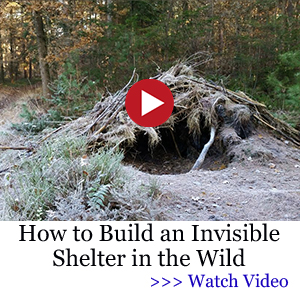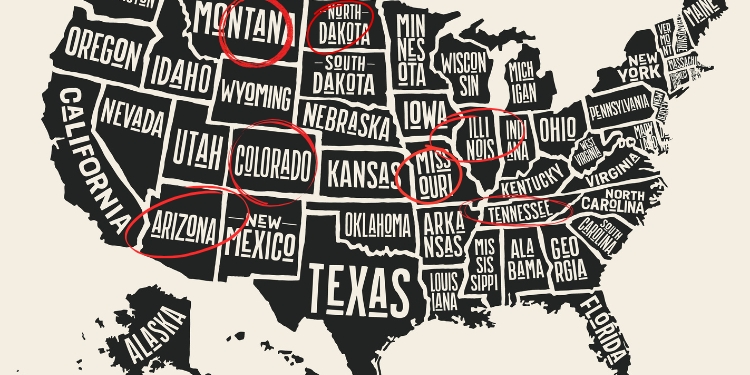States like Montana, North Dakota, Missouri, Arizona, and Idaho are generally considered to be very safe places to live. On paper, they have a modest population density, they don’t tend to be hit by too many major disasters. Since the end of the Cold War, their threat index from attacks by foreign powers seems to have gone down.
Yet these five states, and a few others could become a target for future disasters. Especially when we take into account the potential effects of hurricanes, political instability, and aging infrastructure. Not to mention the threat posed by terrorist organizations who have become increasingly effective at waging asymmetrical warfare.
If you live in one of the following states, or you’re thinking about moving to one, it might help to take a hard look at how they might soon become a target. Always think about the safety of your family and those close to you.
Let’s Have A Word!
Before we talk about the 7 “safe” states that might soon be a target, we have to discuss safety as a whole. It does not matter where we live. Any area can become a target and can become dangerous. Unless you have a huge bunker or a property surrounded by advanced safety features, this includes you!
I understand that there are many things that might stop you from leaving your home, BUT there are moments when you have to. You should have at least a small bug-out bag prepared for that and you need to arm yourself with the most important survival weapon you have: KNOWLEDGE!
Learning how to survive in the wild is a skill that you learn. A great place to start is the Wilderness Long-Term Survival Guide.
 This book teaches you all the fundamentals you need to survive in harsh conditions, when you are forced to live your home. It also helps you improve your own home security. Some of the things you learn include:
This book teaches you all the fundamentals you need to survive in harsh conditions, when you are forced to live your home. It also helps you improve your own home security. Some of the things you learn include:
- The 10 knots every person should know in the wild
- Life-Saving tools you can create in the wild
- How to make a self-feeding fire that lasts up to 14 hours
- How to make your own weapons with natural materials
- How to collect clean, drinkable water from plants
- Traps you can use to catch your next meal while you sleep
- And more
I am also highlighting the Wilderness Long-Term Survival Guide because it is now available at a pretty big discount. Also, the number of physical copies available is limited. Please act fast! This will most likely be one of the best survival books you ever buy!
Grab your physical copy of the Wilderness Long-Term Survival Guide here before it’s out of stock!
Now let’s get back to the core of what we are talking about today.
Illinois
Illinois sits smack in the middle of the country with no international borders for foreign powers to try to exploit. Other than Chicago, much of the state is safe and largely agricultural. You’d be forgiven for thinking that you’re totally safe in Illinois.
Yet when we look a little closer, there are a lot of things that can make it a target for disasters of the natural and manmade kind. This starts with the very real risk of civil unrest and lawlessness in the inner-city portions of Chicago. Gun violence and organized crime have long been a problem.
Chicago and its many skyscrapers are also an unassuming target for international terrorists. In the same way we didn’t think of Boston as a point of entry for the September 11th attacks.
Greater Illinois itself is also a target for natural disasters that are ripe for the picking. Roughly 20% of the state is prone to flooding, with many major towns sitting in flood plains.
A natural disaster that causes widespread flooding could devastate millions of homes and businesses. The relief effort to try to handle such a massive disaster could potentially be even worse than what the remnants of Hurricane Helene did to the area surrounding Asheville North Carolina!
At the same time, the water infrastructure of Illinois is aging on both the municipal and agricultural fronts. Failures or targeted domestic terrorism here could be equally disastrous.
Not to mention what a prolonged drought could do to the largely agricultural base in Illinois. Especially since many of the farms in the state don’t have operational irrigation systems.
Arizona
Arizona’s dependence on water sourced from the Colorado River makes it vulnerable to complications from climate change as well as potential terrorism. Severe drought and the increasing use of water from upstream communities like Las Vegas continue to put stress on the water the Colorado River delivers to Arizona.
This also makes Arizona’s water infrastructure a tantalizing target for terrorist cells and foreign powers. At the same time, Arizona is on the front lines when it comes to concerns about border security.
Many of the dangerous cartels in Northern Mexico are right across the border from Arizona. Despite some valiant efforts toward border security, Arizona is continually a target for these cartels and the various criminal enterprises they run in the state.
Tennessee
 The population of Tennessee is increasing at a staggering rate, which seems good on paper. Yet the rapid population growth in cities like Nashville has heightened its political profile, while also placing stress on the municipal infrastructure.
The population of Tennessee is increasing at a staggering rate, which seems good on paper. Yet the rapid population growth in cities like Nashville has heightened its political profile, while also placing stress on the municipal infrastructure.
Hurricane Helene also revealed just how vulnerable the Southeastern Appalachian region is to flooding events. Then the existing infrastructure isn’t set up to handle these disasters.
The hope is that states like Tennessee, Georgia, and the Carolinas took Hurricane Helene as a lesson. Otherwise, when a similar storm strikes in the future, you and the other people living there could suffer repeat consequences.
There’s also some concern in major cities in Tennessee like Nashville, which is growing faster than law enforcement, and the municipal infrastructure can keep up with it. At the same time, it’s become a melting pot for a lot of different types of people who maybe haven’t interacted much in the past.
This could turn out to be a civil unrest powder keg. If a George Floyd-type incident were to happen in Nashville, the local law enforcement presence might not be able to safely contain it!
Montana
I love Montana, and I’m considering moving there in a few years. So, I’m especially keen to the target it can become in multiple scenarios.
The remoteness of Montana can be a major concern if a disaster affects the grid or national transportation network during the winter. While the people of Montana on their own are some of the most self-sufficient and resilient in the country. However, remote population centers like Missoula and Kalispell have become increasingly dependent on the transport of goods from elsewhere.
Montana could also be a target for a-symmetrical warfare in the future in multiple ways. There are still a lot of active nuclear missile silos and other military targets in Montana. Not to mention some very remote stretches of loosely patrolled border, which a terrorist could pass through.
There’s also a concern for Montana and the communities around Yellowstone and Glacier becoming targets for biological warfare. COVID-19 showed us how easily a pathogen can travel, and one introduced around Livingston, West Yellowstone, Bozeman or Kalispell could quickly spread throughout the US when tourists return home.
North Dakota
You’d think that it’s just the long grueling winters that are a threat in North Dakota. Yet its increasing value to the US energy industry could make it a potential target for foreign powers and terrorist organizations engaging in asymmetrical warfare.
The oil fields in North Dakota currently produce roughly 10% of US oil and that number looks to only increase in the future. Yet if something were to happen to the oil fields or the rail lines that transport the crude oil, the remoteness would be challenging.
It’s this same remoteness that could be an issue if a disaster like an EMP strikes the US during the wintertime. This is a time of year when large parts of North Dakota are reliant on outside resources.
Missouri
Sitting in the middle of the country, without a lot of resources worth targeting by a foreign power, Missouri seems pretty safe. Yet the looming threat in Missouri comes from the New Madrid fault and the chain reaction of problems it could wreak on the Show Me State.
You see there’s a lesser-known fault in the central Mississippi Valley, that extends from northeastern Arkansas, through southeastern Missouri, and western Tennessee, that only goes off every century or two. Yet when it does there are major seismic events that would devastate the aging infrastructure of Missouri.
This would also expose the vulnerability of Missouri’s agricultural system. Not to mention its fragile transportation infrastructure. This could leave remote areas devastated and unable to receive aid while trapping hundreds of thousands of people in dense urban areas like St. Louis.
Colorado
 Everyone knows about Cheyenne Mountain, but with the end of the Cold War, it hardly seems like a target for foreign powers. This makes Colorado sitting in the middle of the country feel like a very safe state to live in. For the most part, it is.
Everyone knows about Cheyenne Mountain, but with the end of the Cold War, it hardly seems like a target for foreign powers. This makes Colorado sitting in the middle of the country feel like a very safe state to live in. For the most part, it is.
Yet there are multiple looming threats that, if the timing was just wrong, could become a perfect storm of disaster. It all starts with the availability of water.
Colorado has experienced an increasing number of droughts and drought months. Not to mention four severe drought years in the last two decades in 2002, 2012, 2018, and 2020. This has exposed the increased risk of wildfires and the mounting challenges of fighting them in such rugged high-altitude terrain.
Population growth throughout the Rocky Mountain state also faces a higher demand for water and municipal infrastructure. However, much of Colorado’s available water comes from snow melt and rainfall, which can become increasingly sparse should another massive drought strike the area.
At the same time, the population influx into Colorado could increase the risk of civil unrest. So many different types of people with different political and lifestyle views make for an interesting dynamic that’s worth being mindful of.
Final Thoughts
Now, I’m not saying that the seemingly safe states on this list are too dangerous to live in or move to. Yet if you’re contemplating a move or already living in Illinois, Missouri, Montana, Colorado, or one of the other states on this list, it’s wise to be mindful of the potential threats.
You can then customize your preparedness strategy around the specific dangers in your area. This might mean keeping an inflatable raft if your home is in an Illinois flood plain, or perhaps keeping extra water stores in your garage in Arizona. By looking at the particular risks in your state with your eyes wide open you increase your chances of keeping yourself, and your family safe when a problem occurs.
You may also like:
 You Should Never Ask Your Neighbor This
You Should Never Ask Your Neighbor This
How to get your own Independent Source of Water (Video)
Places to Avoid After an EMP Strike
Cowboy Cough Syrup with Whiskey
8 Old West Cowboy Recipes
Read the full article here
